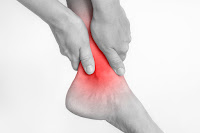What Is Causing It and How Can I Help Them?
By Dr. John Goodner
 |
| Dr. Goodner is a Board Qualified Reconstructive Foot & Ankle Surgeon specializing in sports medicine foot and ankle injuries, arthroscopy, trauma & deformities in patients of all ages. |
Why is my child having heel pain?
This type of heel pain typically occurs after overactivity in children between the ages of eight and fourteen. Tight muscles in their lower extremities, especially the calves and hamstrings, are usually to blame for the pain's onset.
Many children who experience heel pain like this have associated flatfeet as well. Growth spurts can aggravate the condition further due to your child's body trying to adjust to the increased tension from already tight muscles on the calcaneal apophysis. Poor shoes or walking barefoot on hard surfaces can aggravate the heel's growth plates as well.
How do I know if my child has Calcaneal Apophysitis (Sever's Disease)?
- Your child will display discomfort in the heel bone at the end of an activity.
- You will typically see stiffness in their foot in the morning and pain while walking.
- Their pain will be alleviated by rest and a decrease in activity.
- Stiffness and pain will usually present after a child is done with activity, sits for a period of time and then tries to get up and walk.
- Tenderness to the back, sides and bottom of the heel from touch or grasping of the heel.
- You may notice your child walking on the ball of their foot to avoid touching their heel to the ground.
- Discoloration and swelling likely won't be seen.
- Limping at the end of activity that persists as the condition worsens is another sign.
How can my child's pain get better?
There is always a need to modify or avoid activities that aggravate the injury and avoid going barefooted. Taping the foot to decrease pulling on the plantar fascia is a good relief option. Proper shoes along with heel lifts can decrease pressure and tension on the heel.
Night splinting to stretch tight calf muscles and arch ligaments can maintain flexibility gained from calf stretching. Custom molded orthotics are necessary to support the foot and help to restore proper alignment in cases where flat feet contribute to the heel pain.
Physical therapy to improve flexibility and diminish inflammation of the growth plate may be necessary if symptoms persist after these home care options and activity modification do not work. Occasionally, immobilization in a cast or brace to completely rest the heel and allow healing may be necessary.
Prognosis is excellent in most cases when a treatment plan is followed.
Click here to book your appointment and get your child back to their best!







